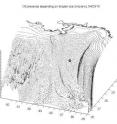Numerical study suggests subsea injection of chemicals didn't prevent oil from rising to sea surface
The 2010 blowout of the Macondo well in the waters of the Gulf of Mexico resulted in the region's largest oil spill in U.S. history. As the Deepwater Horizon (DWH) incident unfolded, in an effort to prevent the oil from coming to the surface and reaching coastal and marsh ecosystems, chemical dispersants were injected at the wellhead. These powerful dispersants, typically used to break up oil slicks at the sea surface had never been used in such large quantities and over such a prolonged period of time in the deep ocean. A new study published in Environmental Science & Technology, led by University of Miami (UM) Rosenstiel School of Marine & Atmospheric Science Associate Professor of Applied Marine Physics Claire Paris, is the first to examine the effects of the use of unprecedented quantities of synthetic dispersants on the distribution of an oil mass in the water column, based on a modeling approach. The team of researchers included UM Rosenstiel School Assistant Scientist Matthieu Le Henaff and Research Associate Professor Villy Kourafalou, UM Center for Computational Science (CCS) Scientist Judith Helgers and Research Associate Professor Ashwanth Srinivasan, Ph.D. Candidate Zachary Aman from Colorado School of Mines, Research Associate Professor Ajit Subramaniam from Lamont Doherty Earth Observatory at Columbia University, and Professor Dong-Ping Wang from the School of Marine and Atmospheric Science of SUNY at Stony Brook. Together they developed and tested models to show that the application of oil-dispersing chemicals had little effect on the oil surfacing in the Gulf of Mexico.
"Deepwater drilling into large, high-pressure reservoirs of oil and gas located far offshore and hundreds of meters below the ocean's surface involves risks for which we were not adequately prepared," said Paris. "As the oil gushed uncontrolled into the Gulf, injection of chemical dispersant into the deep ocean may have had little effect because the oil was coming out with such pressure that it was already dispersed in small droplets. It is impossible to know whether the synthetic dispersant was well mixed with the oil as it was injected. Our models treat both scenarios, and regardless of whether you have the dispersant in the water mixture or not, the amount of oil reaching the sea surface remained relatively unchanged."
The researchers estimated the distribution of oil droplet sizes with and without injection of dispersant at the wellhead. They then applied a novel oil-mass tracking model of the Connectivity Modeling System (CMS) developed shortly after the DWH incident with a RAPID award from the National Science Foundation (NSF) and presented a three-dimensional simulation of the DWH spill showing the unfolding of the disaster to examine the effect the synthetic dispersant may have had on the oil transport in the water column. The model indicated that the dispersant injected at BP's Macondo wellhead was not necessary to break up the oil. The subsea application of dispersant did not have its expected outcome.
"This study is notable because it presents a comprehensive estimate of the Macondo blowout from the microscopic oil-water interface through the macroscopic transport of crude oil." said chemical engineer Aman. The work served as a milestone in assessing the three dimensional transport of oil in the water column.
"Since the beginning of the spill our model accurately predicted the decoupling between the surface and subsea oil transport, and was unique in showing the southwest extension of the deep plume," said physical oceanographer Le Henaff. "Correct assessment of upwelling and downwelling currents for the circulation model created a realistic scenario that we then used to test the effect of the injection of dispersant on the oil partition."
As global deep-sea oil exploration expands, the model will be helpful in quantifying the utility of synthetic dispersants for deep water oil leaks. "The CMS oil model was able to predict the strange layering of oxygen deficit anomalies that we observed during our field sampling and provided us a three dimension view of a phenomena that was constantly changing in time. For us, it was like being able to track the ghosts of the oil plume because the oil itself had been consumed by the microbes and all that was left were the oxygen anomalies and the model was critical for us to understand what we were observing in the field," said biological oceanographer Subramaniam.
These findings expand on a previous study published earlier this year in which the team studied the crucial role of wind-induced surface drift on the fate of the oil in the Gulf of Mexico. "This current study reveals unexplored pathways of the oil transport by underwater currents and highlights the importance of topographic interactions and vertical flows in moving the deep plume toward deep waters or up the water column." said physical oceanographer Wang.
Source: University of Miami Rosenstiel School of Marine & Atmospheric Science
Other sources
- Gulf oil spill: Oil-dispersing chemicals had little effect on oil surfacing, according to new studyfrom Science DailyTue, 4 Dec 2012, 21:40:20 UTC
- Numerical study suggests subsea injection of chemicals didn't prevent oil from rising to sea surfacefrom PhysorgTue, 4 Dec 2012, 18:30:26 UTC
